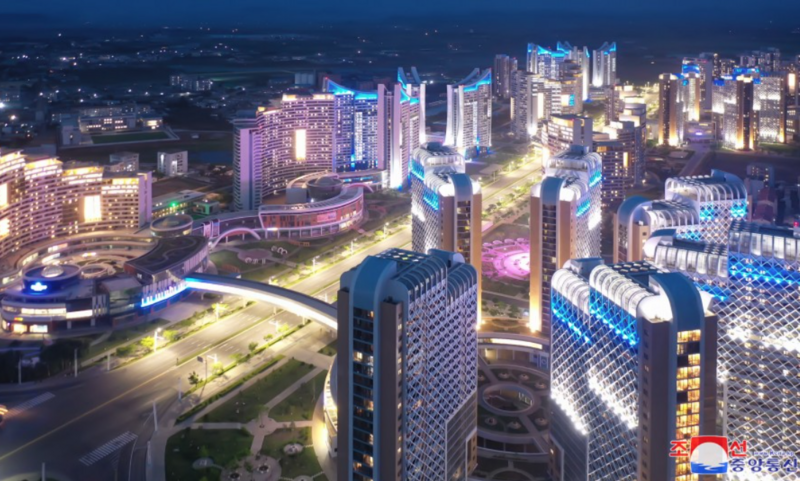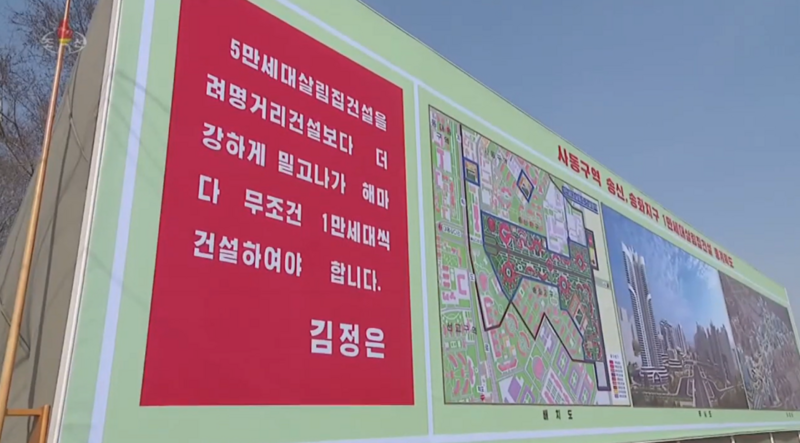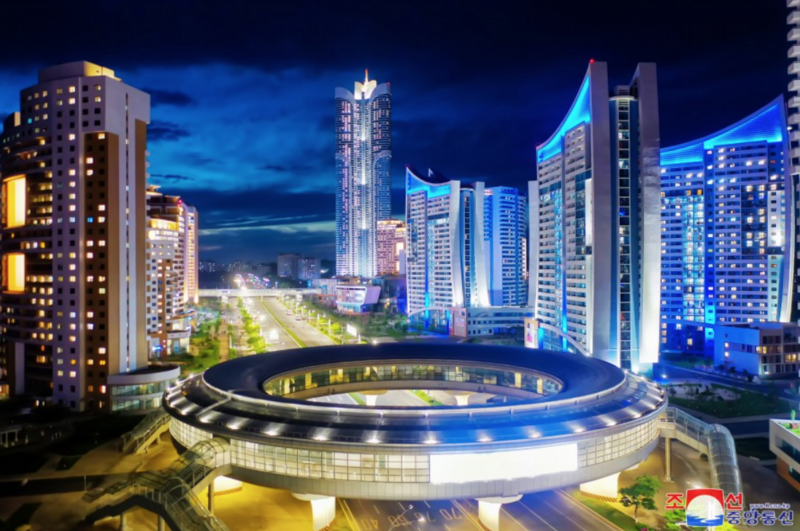Part 2: Buildings on Songhwa Street
In the previous article, we introduced the 50,000 New Flats Project in Pyongyang. In this article, we will introduce the first phase of this project — the 10,000 new flats in the Songsin and Songhwa Area.
This is also known as Songhwa Street.
North Korea Project Phases, What Does it All Mean?
Before we get into the new Songhwa project, let’s discuss the terminology ‘first phase, second phase’, and why they’re in the wrong order..!
"Phase" simply means that a project is completed in steps in North Korea. For example, in the 50,000 New Flats Project in Pyongyang, each phase corresponds to the 10,000 flats planned to be built annually.
Based on the potential appeal of each phase and its attractiveness as a tourist destination, we have rearranged the original order of the phases for introduction.

Songhwa Street at Night
Basic Information of Songhwa Street
On March 23, 2021, North Korea held a ceremony for the first 10,000 new flat construction project in Pyongyang.
The Songsin and Songhwa Area is located in the Sadong district of East Pyongyang, relatively far from the core urban area of Pyongyang.
Upon completion, the Songsin and Songhwa Area received a new official name: Songhwa Street. This street includes four neighbourhoods—two named Songsin and two named Songhwa.
Origin of the Name Songsin and Songhwa
Where do these names come from?
In Korean, Songsin and Songhwa are written as 송신 and 송화. You can see that both words contain the character 송 (Song), which means "Pine."
The origin and explanation of the name Songsin is quite interesting. The two characters directly translate to "pine" and "new" in English. Folklore has it that once upon a time, this area had a lush growth of pine trees. So, a new village was established here, and the villagers primarily made their living by cutting pine trees and selling firewood. Hence, this area got the name “Songsin”.
There is a clever pun in the name “Songsin”: "Sin" in Korean not only means "new" but can also be translated as "firewood." In North Korea's official Chinese translation of this area, "Sin" is interpreted as "new."
Songhwa means 'Pine flower,' named so because the Songhwa area not only has many pine trees but an abundance of pine flowers.
Unfortunately, if you were to take a walk along Songhwa Street today, you couldn’t expect to see lush pine trees and pine flowers. After mass construction, most of the trees here are newly planted and are not pine trees.
Songhwa Street
Let’s take a closer look at Songhwa Street!
Starting with its design.
The overall color tone of Songhwa Street is sky blue, white, and light brown. The architectural style here is quite interesting and distinctive, with the design featuring many circular and curved elements.
At first glance of the layout, the most prominent feature is a series of circular buildings and structures arranged in arc-shaped patterns.
Additionally, many of the buildings have curved roofs and sides, making them instantly recognizable. These buildings set Songhwa Street apart from other new streets in Pyongyang.

The layout of Songhwa Street.
Landmarks of Songhwa Street
Every new street in Pyongyang has its own landmark building.
What about Songhwa Street? What makes this street unique?
One of its landmark buildings is an 80-storey super high-rise residential building known as the Songhwa Street Main Tower. Another landmark on Songhwa Street is its circular viaduct.
The original design for the Songhwa Street Main Tower was for just over 50 storeys, but it was built to 80 storeys to commemorate the 8th Congress of the Workers' Party of Korea.
According to an editorial in Rodong Sinmun, North Korea builds residential buildings with the number of floors equal to ten times the order of the Workers' Party of Korea Congress as a commemoration.
So, that is why you can see a 70-storey residential building on Ryongmyong Street where you take a city walk with Koryo Tours.
In the future, we may even see 90-storey or even 100-storey residential buildings in Pyongyang, so perhaps we can look forward to seeing these buildings in person during future tours.
South Korean media has provided specific data about the Songhwa Street Main Tower. It has more than 80 storeys and measures 282 meters in height, making it the tallest building in North Korea after the Ryugyong Hotel, as well as the tallest residential building.
Interior Condition of the Landmarks
The 1st to 5th floors of the Songhwa Street Main Tower are designated for commercial and service facilities, but more than two years after its completion, only a few shops have opened.
Floors 6 to 80 are for residential purposes, with no residences above the 80th floor. State media once reported that this building is equipped with six elevators, and it takes 90 seconds to take the elevator from the 1st to the 80th floor. Notably, the elevators feature touch screens. Residents manually input the floor they want to go to, after confirming, the elevator begins to operate.
As for the circular viaduct, according to state media, "It serves as a commercial service facility for the local people as well as a traffic route."
However, the shops in the circular viaduct only opened briefly for filming during the completion ceremony. They have remained closed until now. So essentially, it's now just a viaduct for passengers.

The Circular Viaduct of Songhwa Street, the Super High-rise Building in the Back is the Main Tower.

The original design of the street shows the tower only has over 50 storeys.
Viewing New Buildings in Pyongyang from the Sky
What can you expect to see from the new buildings?
A lot of buildings on Songhwa Street are arranged in a circular structure. There's no better way to appreciate this unique feature than by viewing it from above.
Fortunately, if you want to get an aerial view of Songhwa Street, it is possible.
The Mirim Flight Centre offers you the service of viewing Pyongyang from the sky. In 2022, they launched a new route that includes Songhwa Street. You can not only view Songhwa Street from above but also view both classic and new buildings in Pyongyang at the same time.
So if you are interested in viewing new buildings in Pyongyang from the sky, you can expect to experience it by yourself in a Koryo Tours tour in the future.
Since North Korea has announced that international tourism within the Samjiyon area will resume soon later this year, please continue to follow our website and social media to receive the latest information about North Korean tourism.
